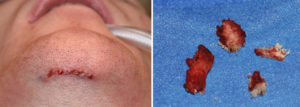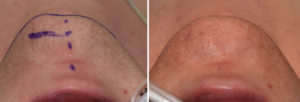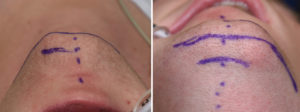Background: The chin is the most projecting part of the lower face. As the most anterior projecting point of the mandible, the chin puts the overlying soft tissue under the most tension of any area of the face other than the nose. As a result the shape of the symphyseal chin bone is readily seen. Whether the chin bone is round or more square or whether a cleft occurs in the bone, its shape is reflected on the overlying soft tissue pad between the mouth and the neck.
While having a clear idea of the shape of the chin bone can be aesthetically advantageous in some people, it is not so when chin bone asymmetry exists. It is striking that even small amounts of differences in the shape of the chin between the two sides can be so readily seen. Such asymmetry, like that of the nose, draws the eye right to it.
The origin of such bony chin asymmetry impacts the treatment needed to correct it. Many such asymmetries come from a developmental issue of the lower jaw and the chin part of the asymmetry is really just a symptom of the overall problem. Other chin asymmetries are more discrete and are isolated just to the chin bone itself. They often occur from trauma to the chin, usually at a younger age, and is the result of a subperiosteal bleed and ossification of this subperiosteal collection of fluid over time.
Case Study: This young male had chin asymmetry that occurred from a fall as a child. He otherwise had a symmetric face and a normal occlusion.The left side of his chin stuck out more than the right and appeared like a bump projecting outward and downward.


Highlights:
1) Most chin asymmetries are bony in origin with the overlying soft tissue mirroring the shape of the underlying bone.
2) A chin asymmetry often has a 3D component to it and this must be considered in the treatment planning.
3) Discrete bony chin asymmetries are optimally treated through a submental incision with a shaving technique to the bone reshaping.
Dr. Barry Eppley
Indianapolis, Indiana



